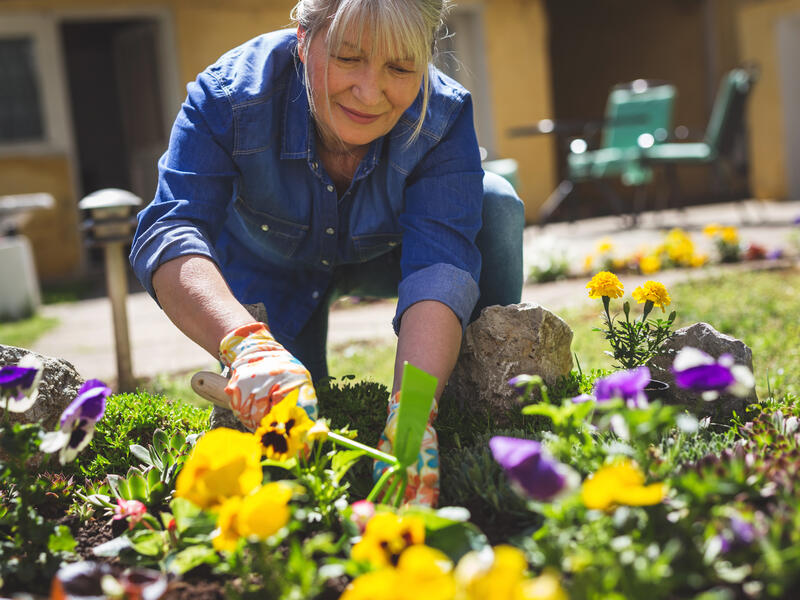Episode Transcript
Simon Floss (host):
Hello, and welcome to the latest “Health and Wellness” podcast, brought to you by the experts at Sanford Health. I’m your host, Simon Floss, with Sanford Health News.
Our conversation today is about joint pain. Helping answer questions that we may have all had at some point is Dr. Cody Sessions, who’s an orthopedic surgeon with Sanford Orthopedics and Sports Medicine.
Thank you so much for being here today, Dr. Sessions.
Dr. Cody Sessions (guest):
Yeah, Simon, thanks so much for having me. Real privilege to be on the ortho podcast. So like you were saying, I’m an orthopedic surgeon with Sanford Bemidji. It’s myself and two other general orthopedists, and we really do kind of do a full spectrum ortho practice, whether or not it’s sports injuries or arthroplasty or fracture care. So joint pain’s a pretty common complaint that we see in clinic, and we’ll be using this time this afternoon to talk about what it is and what we can do about it.

Simon Floss (host):
Awesome. Thanks again for joining us. So as we get started here, tell us just a little bit about Sanford Orthopedics and the types of patients that you see in your clinics. I would imagine it’s pretty much everybody.
Dr. Cody Sessions:
Yeah, I mean it really is. We see kids with elbow fractures all the way up through you know, your grandma with a hip fracture. And in between we see all kinds of derivations of joint pain, whether or not it’s sports injuries or some chronic lingering pain from osteoarthritis or some sort of tendonitis or rotator cuff injury.
Simon Floss (host):
Hmm. So what causes joint pain? Like why does it happen?
Dr. Cody Sessions:
When a joint is not working smoothly, the body compensates by increasing synovial fluid production, thinking that perhaps maybe more oil can solve the grinding problem within the joint. This leads to an increase in pressure in the joint, which will lead to an effusion. And if the pressure gets high enough for long enough, it can create additional spaces of fluids such as a ganglion cyst or a baker cyst. Finally, the irritated state of the knee can cause inflammation to the synovia, which can further increase pain within the joint.
The process can begin from multiple different directions. Sometimes the pain around a joint is not actually coming from inside the joint. For instance, the gluteal tendon, which provides critical hip function, can get irritated and inflamed. This inflammation over the lateral hip is different pathology and can be treated much differently than pain from inside of the joint. Or take for another instance, an autoimmune disease such as rheumatoid arthritis. The problem often starts within the synovium, which is the barrier that keeps the synovial fluid from the joint and ends up damaging the cartilage from a different direction.
Simon Floss (host):
I just find it fascinating that one part of your body might be hurting a lot. Like for instance, I just turned 30 by the way, but I have the back of, like, a 70-year-old and deal with, like, sciatica and all these things. But really the culprit might be tight hips or things like that. So how unique is it that, I guess it’s kind of a funny question, but how unique is it that everything’s connected within your body? Imagine that you know? (Laugh)
Dr. Cody Sessions:
Yeah, no, I would say it definitely is a common occurrence where, you know, a previous injury can cause somebody to change their gait, which then can precipitate some tendonitis in a knee when really the initial injury, like you said, was in the back.
Simon Floss (host):
So are there ways to manage joint pain for patients by themselves?
Dr. Cody Sessions:
Yeah, absolutely. I would say depending on the source of the joint pain, there can be a variety of things that someone can do to manage their pain on their own. For instance, for osteoarthritis of the knee, the American Academy of Orthopedic Surgeons states that there is strong evidence that anti-inflammatories, medications like ibuprofen or Aleve, low-impact aerobic cardiac exercise, and weight management can be quite effective in initially managing your discomfort.
With regards to hip osteoarthritis, there’s also evidence that a cane or a walking stick can decrease the joint forces, which will cause less pain. However, if the source of pain is coming from something else, these treatment modalities may not be so effective. So it’s often wise to come in and be evaluated for persistent pain to ensure that you have the correct diagnosis.
Simon Floss (host):
So you mentioned, like, low impact exercises or low weight-bearing exercises. What would be some examples of that? I would assume maybe swimming or biking or yoga? What would you tell people? What are some examples of that?
Dr. Cody Sessions:
Yeah, I think you got a pretty good idea of what it looks like. So all three of those would be very acceptable. Other things that I encourage people to consider are like an elliptical or an arc trainer at the gym. I would say anything that gets the joint moving without the pounding is probably what’s going to be most beneficial for you.
Simon Floss (host):
Sure, yeah. I’m just curious and picking your brain here a little bit. Everybody’s talking about cryo chambers. They’re all the rage. Or, that cold exposure can help. That one guy Wim Hoff talks about it all the time and I mean, he basically lives in a frozen lake, but does cold therapy or maybe time in the sauna on the opposite side of that, does that have any impact or could that help people out?
Dr. Cody Sessions:
Yeah, I think that’s a good question. And that actually comes up pretty routinely. I would say that a patient comes into my office with a previous recommendation from one of their friends or an experience that they’ve had. And the things that I had previously talked about are the ones that the American Academy of Orthopedic Surgery says that there is multiple studies that say that they do make a difference. A lot of those other things I think people experience a positive effect from, but maybe there’s not the level of evidence to support them or not. So, I don’t think that it hurts to try some of those.
There are some supplements that people like to try and interestingly enough, those aren’t regulated as well by the Food and Drug Administration. So I’d say if you’re going to be, like, taking something, maybe you should talk to somebody before you start trying that. But if you find that ice makes your knee feel good, or heat makes your knee feel good, I think that there’s minimal harm in trying some of those things.
But I guess it would just generally be good practice to run it by your primary care or your sports medicine or orthopedic surgeon before you implemented it for too long or ended up wasting a lot of money on something that maybe has no evidence at all.
Simon Floss (host):
Yeah, sure. I just going to say, I’m sure there’s a lot of like snake oil salesmen out there who would say, “take this turmeric and you’ll never feel knee pain again.” And you know turmeric is fine, I’ve used it and it’s great from time to time. So, what happens if a patient would need professional medical help? What are their options?
Dr. Cody Sessions:
Once non-operative treatments have been exhausted, surgical intervention for joint pain may become necessary. The principle for osteoarthritis is the same for all joints. The goal is to remove the painful arthritic surface and replace it with a new metal and polyethylene joint that will be able to move less painfully. In recent years, advances in surgical practice and anesthesia have changed the surgical experience.
Many patients are now candidates for a same-day total joint, where the patient comes to the hospital for a joint replacement and literally leaves that afternoon to sleep in their own bed. If a patient is a good fit for having surgery, the perioperative team will meet with the patient that day, getting them all the preoperative appointments and labs necessary prior to their surgery routine.
Total joint classes are offered, giving the patient a comprehensive overview of what to expect leading up to their surgery and after. While the initial surgical intervention is not inconsequential, with regards to pain and recovery, Sanford has every resource necessary to guide the patient from start to finish, allowing them to get a surgery that will be necessary to return them to meaningful activities that would’ve otherwise been prevented by their joint pain.
Simon Floss (host):
Great stuff. Dr. Sessions, before we let you go here today, is there anything else you wanted to add or, you know, what would maybe be, like, a take-home message that you would want the listeners to know?
Dr. Cody Sessions:
Yeah, I would say that take-home message, at least from the Bemidji community, is you don’t have to wait for forever. There are definitely things, and just because you come in doesn’t mean that you’re going to get scheduled for surgery or something else, but if you’re out there and your joint is bothering you, come in and see what’s available for you.
Simon Floss (host):
Yeah. Awesome. Well Dr. Sessions, again, thank you so much for joining this conversation today and enjoy that sunny weather in Florida. We’re all, you know, very happy for you, but also equally as jealous. So thanks again for coming in.
Dr. Cody Sessions:
Absolutely. Thank you for having me.
Simon Floss (host):
You bet. This episode is part of the “Health and Wellness” series by Sanford Health. As I mentioned at the top of the show, hear more episodes in this series or some of the other Sanford Health series that we have. You can find those on Apple, Spotify, or Sanford Health News and that link is news.sanfordhealth.org. For Sanford Health News, I’m Simon Floss, and thank you again for listening. Take care.
Learn more about this topic
- What to know about total joint replacement surgery
- Orthopedic walk-in clinics offer more convenience, fast care
- What you need to know about joint pain
Get more episodes in this series
…
Posted In Bemidji, General Surgery, Golf, Healthy Living, Orthopedics, Sanford Sports, Sports Medicine
